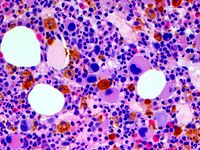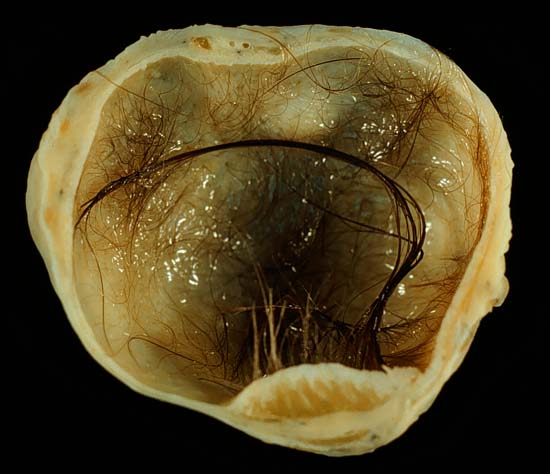Muscle involvement from medical imaging perspective [ edit ] Medical imaging (CT and MRI) has shown muscle damage that doesn't cause obvious symptoms. [22] A single MRI study shows the teres major muscle to be commonly affected. [23] The semimembranosus muscle , part of the hamstrings , is commonly affected, [17] [25] [26] with one author stating it to be "the most frequently and severely affected muscle." [1] Also, MRI shows that the rectus femoris is more often affected than the other muscles of the quadriceps, [25] the medial gastrocnemius is more often affected than the lateral gastrocnemius, [25] [26] and the iliopsoas muscle is very often spared. [26] [1] Non-musculoskeletal [ edit ] The most common non-musculoskeletal manifestation of FSHD is mild retinal blood vessel abnormalities, such as telangiectasias or microaneurysms, with one study placing the incidence at 50%. [ citation needed ] These abnormal blood vessels generally do not affect vision or health, although a severe form of it mimics Coat's disease , a condition found in about 1% of FSHD cases and more frequently associated with large 4q35 deletions. [1] [27] High-frequency hearing loss can occur in those with large 4q35 deletions, but otherwise is no more common compared to the general population. [1] Breathing can be affected, associated with kyphoscoliosis and wheelchair use; it is seen in one-third of wheelchair-bound patients. [ citation needed ] However, ventilator support (nocturnal or diurnal) is needed in only 1% of cases. [1] [28] Genetics [ edit ] The genetics of FSHD are complex, culminating in abnormal expression of the DUX4 gene. [1] [5] In those without FSHD, DUX4 is expressed during embryogenesis and, at some point, becomes repressed in all tissues except the testes . ... The term facioscapulohumeral dystrophy is introduced . [81] 1982 Padberg provides the first linkage studies to determine the genetic locus for FSHD in his seminal thesis "Facioscapulohumeral disease." [16] 1987 The complete sequence of the Dystrophin gene ( Duchenne’s MD ) is determined. [82] 1991 The genetic defect in FSHD is linked to a region (4q35) near the tip of the long arm of chromosome 4 . [83] 1992 FSHD, in both familial and de novo cases , is found to be linked to a recombination event that reduces the size of 4q Eco R1 fragment to < 28 kb (50–300 kb normally). [56] 1993 4q Eco R1 fragments are found to contain tandem arrangement of multiple 3.3-kb units (D4Z4), and FSHD is associated with the presence of < 11 D4Z4 units. [55] A study of seven families with FSHD reveals evidence of genetic heterogeneity in FSHD. [84] 1994 The heterochromatic structure of 4q35 is recognized as a factor that may affect the expression of FSHD, possibly via position-effect variegation . [85] DNA sequencing within D4Z4 units shows they contain an open reading frame corresponding to two homeobox domains, but investigators conclude that D4Z4 is unlikely to code for a functional transcript. [85] [86] 1995 The terms FSHD1A and FSHD1B are introduced to describe 4q-linked and non-4q-linked forms of the disease. [87] 1996 FSHD Region Gene1 ( FRG1 ) is discovered 100 kb proximal to D4Z4. [88] 1998 Monozygotic twins with vastly different clinical expression of FSHD are described. [14] 1999 Complete sequencing of 4q35 D4Z4 units reveals a promoter region located 149 bp 5' from the open reading frame for the two homeobox domains, indicating a gene that encodes a protein of 391 amino acid protein (later corrected to 424 aa [89] ), given the name DUX4 . [90] 2001 Investigators assessed the methylation state ( heterochromatin is more highly methylated than euchromatin ) of DNA in 4q35 D4Z4. ... ISBN 978-0-323-35317-5 . ^ a b c Snider, L; Geng, LN; Lemmers, RJ; Kyba, M; Ware, CB; Nelson, AM; Tawil, R; Filippova, GN; van der Maarel, SM; Tapscott, SJ; Miller, DG (28 October 2010). "Facioscapulohumeral dystrophy: incomplete suppression of a retrotransposed gene" .








